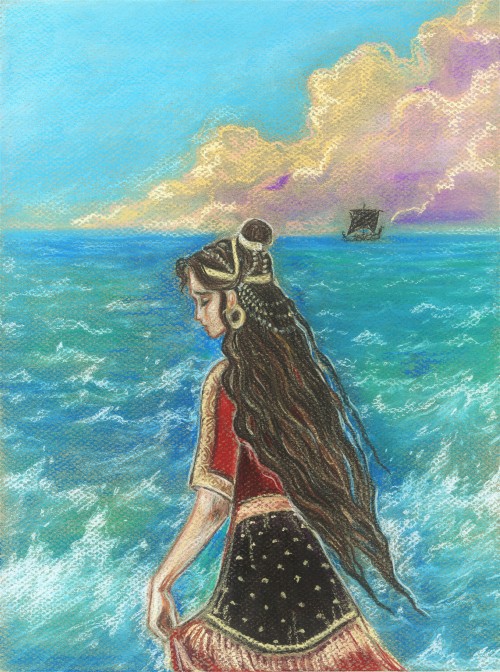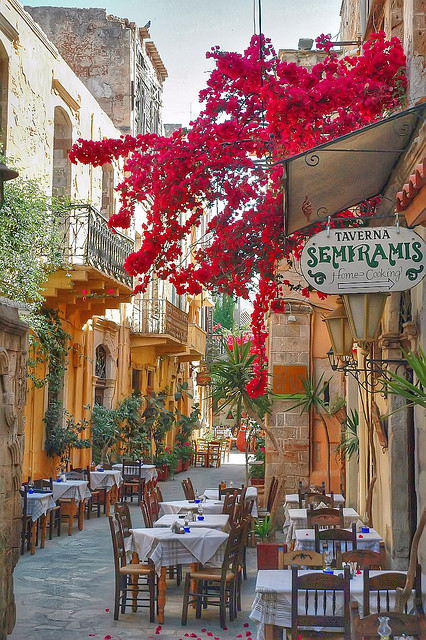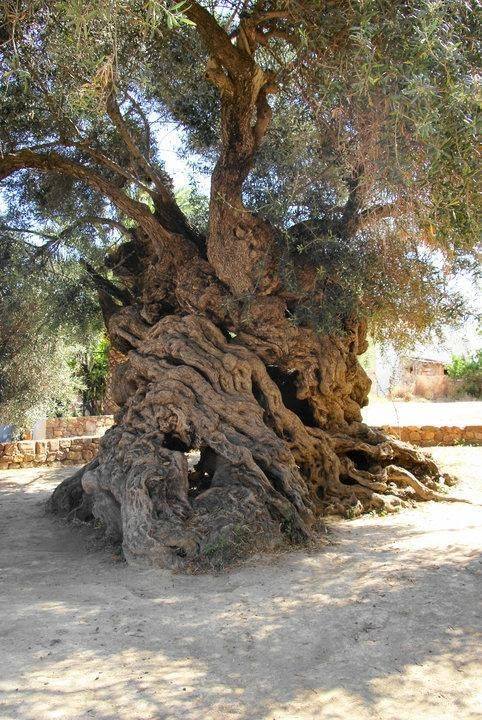Crete - Tumblr Posts

Ariadne’s Tears (2019)

Временное мышление все время мечется вперед-назад над океаном воспоминаний и предчувствий, то и дело возвращаясь к призрачному острову, который мы называем «я». #тайнакоторойнет #тонипарсонс #palace #minos on #crete #island #civilization #fresco

Сколько ни думай, мышление не поможет узнать, кто ты есть, лишь понимание способно приблизить нас к этому #тайнакоторойнет #тонипарсонс #minoan #crete

Kittim: A Symbol of Greece
By Goodreads Author Eli Kittim
——-
Kittim: The Descendants of Greece
According to Gen. 10.4, one of “the descendants of Javan” (Greece) is Kittim. With regard to the actual location of Kittim (or its variants, Chittim [Hb. כִּתִּ֔ים] Kitti or Kittiyyi), most Bible translations identify this region with the island of Cyprus, which was inhabited by Greeks since ancient times (see Josephus “Antiquities” Bk 1, ch. 6). Therefore, it represents the Greeks (otherwise known as the “Ionians”). Given the close proximity of Cyprus to Palestine, this is not surprising since the Hebrew Bible itself mentions that the Philistines themselves originate from Caphtor (most probably Crete/Minoa; Deut. 2.23; Jer. 47.4), a nearby Greek island in the Aegean Sea. Cyprus was also the destination of Paul’s first missionary journey.
Kittim was originally a city-kingdom in present-day Larnaca, known as Kition (Lat. Citium), which was established in the 13th century b.c.e. by Greek (Achaean) settlers. On this basis, the entire island gradually became known as "Kittim" in Hebrew, and was subsequently mentioned by Josephus and the Hebrew Bible (See the Wikipedia article on Kittim: https://en.m.wikipedia.org/wiki/Kittim).

However, the term “Kittim,” in ancient Hebrew literature, began to be applied to all the Greek islands of the Aegean, and subsequently became an umbrella term for the Greek coastlands (see e.g. the expression "isles of Kittim" Jer. 2.10; Ezek. 27.6). So, the term “Kittim” eventually became synonymous with Greece (i.e. Javan cf. Gen. 10.4)!
——-
The Messiah and the Greek Coastland Prophecies
From a theological standpoint, this region is considered important to both Christian and Jewish Messianism. Isaiah 24.15 (NRSV), for example, equates the glory of Yahweh with “the coastlands of the sea”:
Therefore . . . give glory to the Lord; in the
coastlands of the sea glorify the name of
the Lord.
Notice that Isaiah doesn’t say, “glorify the LORD” in Jerusalem, but rather “glorify the name of the Lord” in what appears to be the Greek coastlands. And then, in chapter 51 verses 4-5, Yahweh declares that “the coastlands wait for me,” seemingly suggesting that these same coastlands are central to the coming of Messiah:
Listen to me, my people, and give heed to
me, my nation; for a teaching will go out
from me, and my justice for a light to the
peoples. I will bring near my deliverance
swiftly, my salvation has gone out and my
arms will rule the peoples; the coastlands
wait for me, and for my arm they hope.
Once again, it isn’t Jerusalem but rather the Greek “coastlands” that seem to be associated with the coming of Messiah, symbolized by the arm of Yahweh that “will rule the peoples” (cf. the “son . . . who is to rule all the nations” Rev. 12.5)! This is a recurring motif. Incidentally, according to religious studies professor Ronald Farmer, “the Hebrew people never became a seafaring people. They were a land-based culture.”
An excerpt from ch. 7 of my Book, “The Little Book of Revelation,” from the section entitled, “Messianic Signs of a Seafaring People from the Greek Coastlands,” will explain how this theme is symbolized in the New Testament:
Time and time again, we encounter
passages which foretell of a coming
Messiah whose “glory” and “praise” is
initially declared “in the coastlands.” These
excerpts reveal why Christ’s disciples are
portrayed in the NT gospels as being
predominantly men of the sea (cf. Ezek.
47.9-10). It seems that the gospel narratives
are seeking to establish a connection
between Jesus and “the Greek coastland
prophecies,” which would explain why most
of his disciples turn out to be fishermen! At
least that is the foregoing conclusion of the
text. As an illustration, notice how Isaiah’s
following oracle announces God’s
incarnation while confirming the latter’s ties
to a certain cluster of islands: ‘Listen to me,
O islands, and pay attention, you peoples
[Gentiles] from afar [not from Israel]. The
LORD called Me [the Messiah] from the
womb; from the body of my mother He
named Me. . . . In the shadow of His hand
He has concealed Me, . . . He has hidden
Me.’
If we look closely at the context of Isaiah 49, it becomes rather obvious that the passage is referring to a messianic figure. For example, the phrase “He made my mouth like a sharp sword” is reminiscent of Rev. 19.15: “out of his mouth is a sharp sword with which to strike down the nations.” God says that he sends his servant “as a light to the nations” (v. 6). This reminds us of Jesus who says, “I am the light of the world” in Jn 8.12 (cf. Acts 13.47). He is also given “as a covenant to the people” (v. 8 cf. Mt. 26.28), and so on. Astoundingly, this entire messianic passage is mysteriously addressed to the Greek coastlands.
Most Biblical scholars associate “the coastlands of the sea” (Esth. 10.1; Isa. 11.11, 24.15; Jer. 25.22) with the Greek islands. For example, “the coastland of Capthor” (Jer. 47.4) is commonly associated with the island of Crete. In like manner, the Greek island of Rhodes (known as “Dodanim” [Gen. 10.4], a variant of “Rodanim” [1 Chron. 1.7], a reference to the largest of the Dodecanese islands) seems to be implicated in the text as being one among the “many coastlands” (Ezek. 27.15) that enjoyed a wide range of commercial trade. And it is virtually certain that the term Kittim represents Cyprus, which perhaps got its name from an abundance of cypress trees. After all, was it not Isaiah who once said, “The cypress [Cyprus] tree . . . shall be to the LORD for a name, [and] for an everlasting sign”? (55.13 NKJ). In fact, the sign of Kittim points to the origin of redemption, when God instructed Noah to build an ark made of cypress wood, or wood from Kittim (Gen. 6.14 cf. Ezek. 27.6):
Make for yourself an ark
of cypress wood. Make
rooms in the ark, and
cover it with pitch inside
and out.
——-
The King of Kittim in the War Scroll
The Old Testament references to Kittim are as important to Christian eschatology as they are to Jewish eschatology. For example, the “ships of Kittim,” in Num. 24.24 and especially in Dan. 11.30, seem to have eschatological value given that Bible prophecy scholars have linked them to forces that oppose the Antichrist, probably during the Gog and Magog War of the end-times. Similarly, the Kittim reference in Isa. 23:1 appears to have eschatological import as the verse contextually suggests a precursor to the fall of Babylon in Rev. 18.
But the famous “War Scroll” (aka 1QM), found among the Dead Sea Scrolls, contains prophecies of the final battle between the forces of light and the forces of darkness. Two opponents will square off at the end of time: Belial (whose forces face “eternal annihilation” (1:5 cf. Column 13, Line 4) versus the king of the Kittim (cf. 2 Cor. 6.15-16). The undermentioned quote distinguishes the identifiable hallmark of the Kittim within the War Scroll, namely, that they are those who oppose the so-called “rule of darkness.” This fact can be evidenced by the following lines included in the 1QM manuscript (Column 15, Lines 2-3):
All those pr[epared] for battle shall set
out and camp opposite the king of the
Kittim and all the forces of Belial that are
assembled with him for a day [of
vengeance] [sic].
Notice that both Belial and those who “camp opposite the king of the Kittim” represent the Kittim’s conspicuous adversaries. Therefore, this brief study demonstrates the chief protagonists in the war of Armageddon: Belial, defying his archaic archrival, the king of the Kittim.
——-
Conclusion
Given that the Greek coastland prophecies make reference to the isles of the Kittim (Num. 24.24), and that the Kittim (the people of Cyprus) are the sons of Greece (Gen. 10.4), there is considerable evidence to substantiate the claim that the king of the Kittim signifies the incarnation of an end-time King-Messiah who will step onto the world stage as the progeny of Greece! In fact, it was from the Greek Coastlands that John the Revelator first proclaimed the coming of Christ in Rev. 1.9:
I, John, your brother . . . was on the island
called Patmos because of the word of God
and the testimony of Jesus.
(see my article “Jesus is a Gentile”: https://eli-kittim.tumblr.com/post/106110545257/jesus-is-a-gentile-the-evidence-from-the-gospels).
——-
I’ve been there. It’s lovely. And lots of history to look at in Crete should relaxing by the Med get boring (as if).

Rethymno, Greece
“The oldest olive tree in the world located on the island of Crete. It is estimated to be as over 3,000 years old and still produces olives.”
—


Created by a Greek god, Talos was a metallic giant that guarded the island of Crete. Greek myths say that this beast broke huge chunks of rock off the cliffs to throw at approaching ships and burned men on his blazing bronze skin, which was nearly as hot as the sun. The giant's brute strength could wipe out an invading army.
Talos was said to be a metallic giant made entirely out of bronze, and stood about 30 feet tall. This beast was crafted atop Mt. Olympus by Hephaestus, the god of blacksmiths, and sent by Zeus to guard the shores of the island of Crete.
This legendary giant was given life by a fluid called ichor, which was the blood of the gods. Ichor ran through a single vein that stretched from Talos' neck to his heel. A nail was used as a plug in the giant's foot to keep the fluid from running out.
His name comes from the Latin word "talus," which means "enduring".
Plus, fun fact, Hephaestus, the god that created Talos, also made metallic dancing women and fire-breathing bulls.










